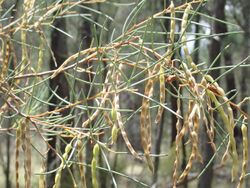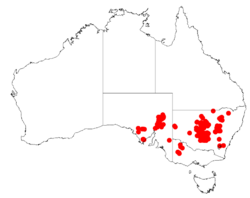Biology:Acacia havilandiorum
| Acacia havilandiorum | |
|---|---|

| |
| Scientific classification | |
| Kingdom: | Plantae |
| Clade: | Tracheophytes |
| Clade: | Angiosperms |
| Clade: | Eudicots |
| Clade: | Rosids |
| Order: | Fabales |
| Family: | Fabaceae |
| Subfamily: | Caesalpinioideae |
| Clade: | Mimosoid clade |
| Genus: | Acacia |
| Species: | A. havilandiorum
|
| Binomial name | |
| Acacia havilandiorum Maiden
| |

| |
| Occurrence data from AVH | |
Acacia havilandiorum, also known as Haviland's wattle or needle wattle,[2] is a shrub of the genus Acacia and the subgenus Plurinerves. It is native to areas in South Australia, New South Wales and Victoria.
Description
The bushy shrub or small typically grows to a height of 1.5 to 4 metres (5 to 13 ft)[3] and has glabrous and terete branchlets. Like most species of Acacia it has phyllodes rather than true leaves. The grey to green, inclined to ascending and straight or slightly incurved, rigid phyllodes are 3 to 9 cm (1.2 to 3.5 in) in length and 0.8 to 1.5 mm (0.031 to 0.059 in) wide and are quite brittle and tend to break easily.[2] It blooms between July and October producing simple inflorescences which occur in group of one to three in the axils and have spherical flower-heads with a diameter of 3 to 7.5 mm (0.12 to 0.30 in) and contain 20 to 30 bright yellow coloured flowers. Following flowering it produces glabrous and firmly papery seed pods which are straight to curved and raised over each seed and slightly constricted between them and have a length of 3 to 9 cm (1.2 to 3.5 in) and a width of 2 to 3 mm (0.079 to 0.118 in).[4]
Taxonomy
The species was first described by Joseph Maiden in 1920 as Acacia havilandi,[5][6] despite the specific epithet honouring both Edwin Haviland and his son,[4] who " specialised in the fertilisation of Australian plants and (have) also worked at taxonomy and other branches of botany"[5][6] The epithet was changed to a genitive plural (havilandiorum) to accord with ICN Art. 60.8 (Shenzhen Code, 2018).[5]
Distribution
The plant has a scattered and discontinuous distribution from as far west as the Eyre Peninsula in South Australia where it is common, to further north in the Flinders Range through to Griffith and Cobar but the range extends as far as Gilgandra in the east. It is only known around Horsham in the north west region of Victoria.[2] In New South Wales the plant is mostly found in the Pilliga Scrub between Gilgandra and Milgee as a part of mallee and box woodland communities.[4]
See also
References
- ↑ Gowland, K. (2022). "Acacia havilandiorum". IUCN Red List of Threatened Species 2022: e.T200142542A200149804. doi:10.2305/IUCN.UK.2022-1.RLTS.T200142542A200149804.en. https://www.iucnredlist.org/species/200142542/200149804. Retrieved 22 April 2023.
- ↑ 2.0 2.1 2.2 "Acacia havilandiorum Maiden". Wattle - Acacias of Australia. Lucid Central. https://apps.lucidcentral.org/wattle/text/entities/acacia_havilandiorum.htm. Retrieved 28 November 2020.
- ↑ "Acacia havilandiorum". World Wide Wattle. http://worldwidewattle.com/speciesgallery/havilandiorum.php. Retrieved 21 May 2016.
- ↑ 4.0 4.1 4.2 "Acacia havilandiorum Maiden". PlantNet. Royal Botanic Garden, Sydney. https://plantnet.rbgsyd.nsw.gov.au/cgi-bin/NSWfl.pl?page=nswfl&lvl=sp&name=Acacia~havilandiorum. Retrieved 28 November 2020.
- ↑ 5.0 5.1 5.2 "Acacia havilandiorum". Australian Plant Name Index (APNI), IBIS database. Centre for Plant Biodiversity Research, Australian Government. https://biodiversity.org.au/nsl/services/rest/name/apni/135274.
- ↑ 6.0 6.1 Maiden, J.H. (1920). "Notes on Acacias, No. IV, with descriptions of new species". Journal and Proceedings of the Royal Society of New South Wales 53: 182-186. https://www.biodiversitylibrary.org/page/41519943.
Wikidata ☰ Q15287259 entry
 |


